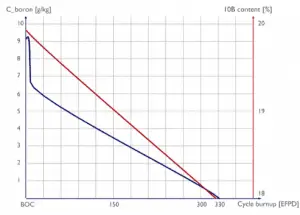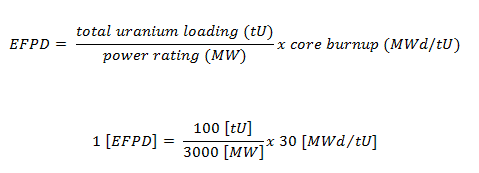In nuclear engineering, we have to distinguish between the
neutron flux density, the
neutron intensity, and the
neutron fluence.
Neutron fluence, previously referred to as the neutron dose, is defined as the time integral of the neutron flux density, expressed as the number of particles (neutrons) per cm2. Neutron fluence is primarily defined for material engineering but is widely used by reactor engineers as a unit of fuel burnup.
Neutron Fluence and Fuel Burnup – Neutrons per Kilobarn
Neutron fluence can be used as a measure of fuel burnup as well since reaction rate is given by the product RR = Ф . Σ, the rate of burnup is proportional to the neutron flux. The accumulated burnup over a specific period (t) is therefore proportional to the product of flux and time (F = Ф . t or F = ∫Фdt). This product is known as the neutron fluence or the total neutron exposure of the fuel. The units of neutron fluence are also neutrons per m2, but, in practice, it is often expressed in neutrons per kilobarn:
1 n/kb = 1025 neutrons per m2
For example, let assume the fuel in PWR, which is irradiated with flux on the order of 3×1017 neutrons.m-2s-1 for approximately 4 years. The total fluence of discharged fuel is then 4 n/kb.
Neutron Fluence and Irradiation Embrittlement
During the nuclear power plant operation, the material of the reactor pressure vessel and the material of other reactor internals are exposed to neutron radiation (especially to fast neutrons), which results in localized embrittlement of the steel welds in the area of the reactor core. Irradiation embrittlement can lead to loss of fracture toughness. Typically, the low alloy reactor pressure vessel steels are ferritic steels that exhibit the classic ductile-to-brittle transition behavior with decreasing temperature. This transitional temperature is of the highest importance during plant heat up.
Failure modes:
- Low toughness region: Main failure mode is the brittle fracture (transgranular cleavage). In brittle fracture, no apparent plastic deformation takes place before fracture. Cracks propagate rapidly.
- High toughness region: Main failure mode is the ductile fracture (shear fracture). In ductile fracture, extensive plastic deformation (necking) occurs before fracture. Ductile fracture is better than brittle fracture because there is slow propagation and an absorption of a large amount of energy before fracture.
Neutron irradiation tends to increase the temperature (ductile-to-brittle transition temperature) at which this transition occurs and tends to decrease the ductile toughness.
Since the reactor pressure vessel is considered irreplaceable, neutron irradiation embrittlement of pressure vessel steels is a key issue in the long-term assessment of structural integrity for life attainment and extension programs.
Radiation damage is produced when neutrons of sufficient energy displace atoms (especially in steels at operating temperatures 260 – 300°C) that result in displacement cascades which produce large numbers of defects, both vacancies and interstitials. Although the inside surface of the RPV is exposed to neutrons of varying energies, the higher energy neutrons, those above about 0.5 MeV, produce the bulk of the damage. To minimize such material degradation type and structure of the steel must be appropriately selected. Today it is known that the susceptibility of reactor pressure vessel steels is strongly affected (negatively) by the presence of copper, nickel, and phosphorus.
To minimize neutron fluence:
- Radial neutron reflectors are installed around the reactor core. Neutron reflectors reduce neutron leakage, and therefore they reduce the neutron fluence on a reactor pressure vessel.
- Core designers design the low leakage loading patterns in which fresh fuel assemblies are not situated in the peripheral positions of the reactor core.
Heating the irradiated steel to a temperature sufficiently above the irradiation temperature can mitigate the embrittlement. At the normal operation of LWRs, the RPV material temperature is far from this temperature. Therefore, when required, plant operators must perform thermal annealing of irradiated reactor pressure vessel material to restore the mechanical properties. The degree of recovery for given steel depends on the time and the temperature at which annealing is performed.
See also: Integrity of reactor pressure vessels in nuclear power plants: assessment of irradiation embrittlement effects in reactor pressure vessel steels. International Atomic Energy Agency, ISBN 978-92-0-101709-3, Vienna, 2009.

